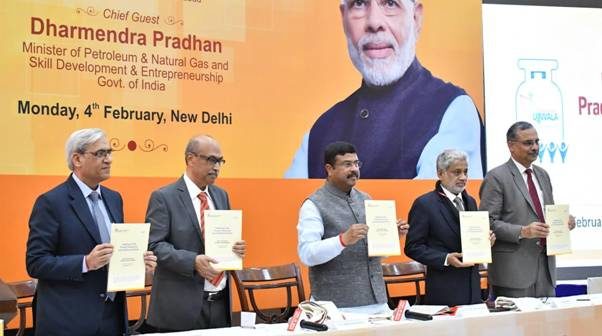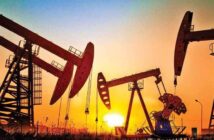Union Minister of Petroleum and Natural gas & Skill Development & Entrepreneurship Shri Dharmendra Pradhan was today handed over a case study on Pradhan Mantri Ujjwala Yojana (PMUY), undertaken by Professor SK Barua, former Director and Faculty member, IIM, Ahmedabad, after its registration.
In order to chronicle the journey of Pradhan Mantri Ujjwala Yojana (PMUY), one of the largest social transformation programmes in the country to provide clean cooking fuel to Indian kitchens, a case study titled “Lighting up Lives through Cooking Gas and transforming Society” has been developed byProfessor SK Barua, former Director, IIM – Ahmedabad, and one of the leading academicians in the country. The case study aims to understand how a seemingly simple mechanism of providing universal access to LPG has transformed the lives of the destitute, empowering them through socio- economic inclusion.
Speaking on the occasion, Shri Pradhan said that the scheme is a win-win situation for all the stakeholders- Government, OMCs, Distributors, Banks and Consumers as it has good impact on economy, society, environment and health. He said that the Scheme is an example that determination, good intentions, leadership and perseverance can help in overcoming the challenges. Lauding the efforts of Prof Barua, the Minister said that it has not only done the critical examination of the scheme, but has also shown the way ahead. He said that the government will meet the target of 8 crore connections under the scheme by next financial year. Shri Pradhan said that Hon’ble Prime Minister is keen that the Scheme should go beyond its original mandate and bring about constructive change in the lives of poor of the country. He said innovative financing scheme can be brought to help the poor in refiling the cylinders. Further, efforts can also be made to give choice to the consumers to fill as much as gas they want, irrespective of the size of the cylinder. The Minister also talked about the Compressed bio-Gas, increasing the use of solar energy, and using other renewable energy sources. He said that the women using gas connections through PMUY now have some spare time, and many of them can be trained and equipped to become socio-economic entrepreneurs. Shri Pradhan also congratulated all the stakeholders in putting earnest efforts in making this scheme a huge success.
Prof Barua, Dr M.M.Kutty, Secretary, Ministry of Petroleum and Natural Gas also spoke on the occasion.
The case study encapsulates the journey ofPMUY, right from its genesis, to the benefits it has accrued to those who now have access to LPG for the first time, thanks to the scheme. The case study also highlights the important role timely policy intervention plays in weeding out the loopholes and ensuring that the social welfare scheme serves every poor household in the country.
Ithas been developed after thorough research through primary and secondary data gathering. The author and his team have extensively interacted with the beneficiaries and have detailed how LPG has played a crucial role in bringing the marginalized into the mainstream. The team interacted with beneficiaries from various parts of the country, be it Odisha, Gujarat or UP, to understand regional sensibilities and on-ground status.
The case study has now been registered and can be used by management schools across the globe for insights on management of such large scale social interventions. The case study shall share India’s experience with the world, making PMUY a role model for many other countries to emulate.
Key Findings of the Case Study:
The key findings of the case study are as follows:
The scale and speed of implementation were achieved through excellent coordination between the government system, the government-owned Oil Marketing Companies (OMCs) and the banking system. The government system represented by officials from the central government, the state governments, and the village heads (Sarpanchs) helped in identifying BPL beneficiaries and in mobilizing people to accept the idea of switching over to LPG from traditional fuels for cooking. The OMCs (the three companies involved in the implementation were IOCL, BPCL and HPCL) designed and created robust logistics system needed for bottling and distribution of cooking gas cylinders. They also designed and created the IT platform required for easy transaction and record keeping for the entire logistics system. Banks provided the infrastructure needed for flow of funds, including flow and accounting of subsidies from the government.
PMUY is clearly one of the largest social intervention schemes executed anywhere in the world in sucha challenging environment. Its successful implementation provides insights into management of such interventions. The lessons that can be drawn from the implementation would be of use for similar large- scale social interventions.
Issues for the Future as mentioned in the Case Study:
While the scheme had been conceived by the Prime Minister, as Minister for Petroleum and Natural Gas, Mr. Pradhan had been the key driver of Ujjwala. The program had been designed to achieve: a) social transformation through empowerment of women, b) elimination of corruption in allotment and consumption of LPG, c) economic transformation of rural India, and d) halting of environmental degradation due to felling of tress for fuelwood. From the beginning, Mr. Pradhan was clear that the program must be achieved with limited burden on public funds. He had been able to motivate the OMCs – and they had responded splendidly to effectively implement the program with use of technology and their reach in rural India.
The PMUY is being implemented when the crude and LPG prices in the international market are benign. If these were to rise in the future then the cost of use of LPG would rise for the BPL families, unless the subsidy provided is increased to nullify the rise in price. Increase in cost may result in these families going back to traditional fuel. Preventing such relapse will require the government to set aside more funds for energy subsidy. What policy choices should be made when faced with such a situation?
Solar energy is becoming cheaper over time and India is blessed with sunny days throughout the year. It has the advantage of easy deployment to far-flung areas. Could this become the alternative source of primary energy not too far into the future? If that were to happen, what should be the policy glide path for transition from LPG to solar energy for cooking?
Ujjwala had released considerable amount of time of women (as well as men, who would not spend time in collecting fuel wood) as the time and effort needed for cooking would be much less. How could this time be productively utilized to enhance the rural household incomes? What would be the contours of such extensions arising from Ujjwala? It would be useful to carry out an impact assessment of the program by a credible third party. While internal assessment by the government and OMCs had indicated that there were significant benefits, a third party assessment would be more credible.




